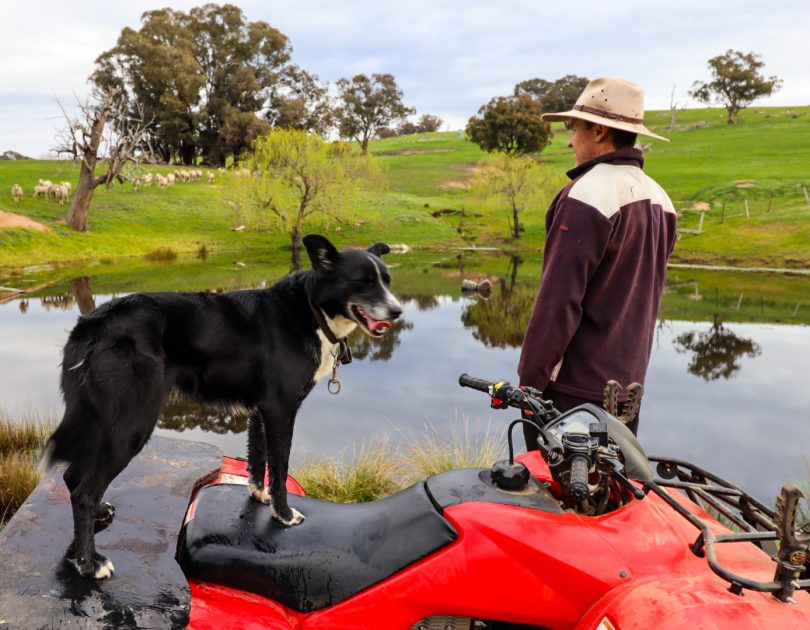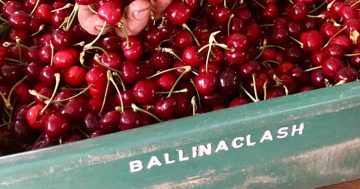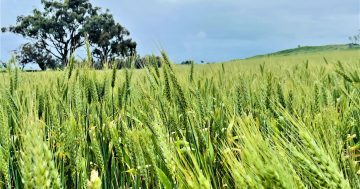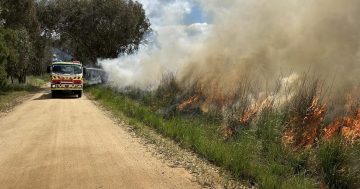
Grazier Will Picker of ‘Avondale’, Bigga, in the Upper Lachlan Shire looks at a full dam following recent welcome rain. Photo: Supplied.
Recent rainfall has brought relief to Southern Tablelands farmers after years of drought.
Grazier Dave Ward said the rain was enough to break the drought on his property at Bungonia near Goulburn.
Spring Ponds received a soaking of 133.4mm in the first week of August, following 42.4mm in July.
“I think it will be an unbelievable spring,” said Mr Ward. “We are going into the season with a full soil moisture profile and good ground cover, everything fertilised.”
Soil moisture at Spring Ponds is at 100 per cent at the level of 20cm; at 86 per cent at 40cm; and 88 per cent at 60cm.
Grazier Will Picker of ‘Avondale’, Bigga, in the Upper Lachlan Shire, also said his property is no longer in drought, despite the area receiving significantly lower rainfall than Bungonia – 36.6mm in August and 49.8mm in July.
“All but one of our dams are now full and it’s great to see the place looking so green again,” said Mr Picker.
Grazier George Henderson of ‘Grogansworth’, Bowning, in the Yass Valley, said he can’t remember a winter like it.
“Pasture growth in July was probably the best in living memory with very mild weather conditions and now with a full moisture profile,” he said. “We are well set up for spring.”
‘Grogansworth’ received 65mm in July and 93.8mm at the beginning of August. The property’s soil moisture is at 100 per cent, down to 40cm, and 94 per cent at 60cm.
With dams full and healthy soil moisture across the Yass Valley Council, Upper Lachlan Shire Council and Goulburn Mulwaree Council, South East Local Land Services agricultural advisor Matt Lieschke said the Southern Tablelands is “definitely in the recovery phase” of drought.
“We have had one of the best starts to the year we could have hoped for and farmers can be optimistic about a good spring – something we haven’t seen for years,” he said.
Mr Ward’s other property at Cooma – one of the worst-hit areas by drought – received welcome rain. He plans to return sheep there shortly.
“It will turn around down there now,” he said.
The Riverina, Central Tablelands and areas between Wagga Wagga and Canberra have also had a good start to the year, said Mr Lieschke. And the amount of rain received hasn’t been the only reason to celebrate.
“The timing of the rain couldn’t have been more perfect,” said Mr Lieschke. “We had a really good autumn and then it dried up a bit in June and July. But in hindsight, I think that was a good thing because a really wet winter would have caused more issues with stock, such as foot abscess. Now this latest bit of rain has topped things up.”
Farmers can also be optimistic heading into summer with the Bureau of Meteorology predicting above-average rainfall in September and October, said Mr Lieschke.
In the meantime, he advised farmers to watch out for foot abscess and said to move sheep, particularly pregnant ewes, into well drained paddocks with roads or banks that allow sheep to camp on dry ground. He also advised farmers to currently avoid yarding sheep.
“Foot abscess is starting to ramp up,” he said. “There seems to be a lot around Young, Boorowa and Yass because they lamb a little bit earlier. That issue will start to creep towards those areas which lamb later, around Goulburn and Crookwell, particularly after this big dump of rain.”
Mr Lieschke warned people who are thinking of taking advantage of the pasture growth that hay prices may drop.
“With a lot of feed in paddocks now, and the indication there will be more in spring, producers are thinking of how to use that surplus feed,” he said. “The question is do you take on more stock, agistment or conserve some into hay or silage.
“With the high price of stock at the moment, taking on more is a pretty expensive exercise. Making hay and silage to replenish reserves diminished in the drought is a good idea, but trying to make hay and silage to sell might not be such a good idea.
“The fodder industry is saying hay and silage prices will come back to more long-term average price levels because it has been a good season across such a big area.”







